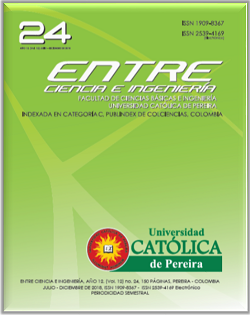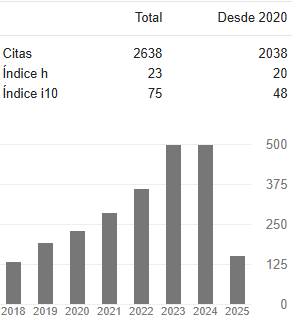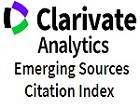Trajectory Planning by A * technique and smoothing by Bezier curves for the tool of the weed removal system of a robot dedicated to precision farming.
DOI:
https://doi.org/10.31908/19098367.3814Keywords:
Mobile Robotics, Precision Farming, Weed Removal, Path Planning, A*, BezierAbstract
The ground and aerial robotics, is being putinto operation of agribusiness. Precision agriculture taskshave opened a dominant fi eld to integrate the developmentsof mobile robotics. Trajectory planning is an option for weedremoval systems from a 3D image processing system. Thissystem determines the location of the weed (not treated here)and plans the movement of the tool to eradicate it. This toolis called end eff ector and it is integrated into a positioning system XYZ. This one is found on a mobile platform calledCeres_AgroBot (Robot created for agricultural work), whomoves through the crop and performs inspection-removal. Thearticle treated here presents a solution to find the trajectorythat must follow the tool that removes the weeds from the crop,without colliding with the plants of interest. It is based on theimplementation of a search algorithm supported on the A*,technique for determining the path in 3D space with obstacles.As inputs are: the rest point of the tool (), the coordinate ofthe weed () and the coordinates of the objects. Sometimesthe trajectory found produces movements that cause suddendisplacements and strong actions in the actuators, so it is alsopresented, the way to integrate the smoothing of the trajectoryby the Bezier techniques, such that the curve is adjusted to adynamic continuous and appropriate to the elements that makeup the removal system
Downloads
References
Stafford, J. V., “Implementing precision agriculture in the 21st century”, J. Agric. Eng. Res., vol. 76, no. 3, pp. 267–275, 2000.
Zhang, N., Wang, M. and Wang, N., “Precision agriculture—a worldwide overview”, Comput. Electron. Agric., vol. 36, no. 2–3, pp. 113–132, 2002.
Lamb, D. W. and Brown, R. B., “Remote-Sensing and Mapping of Weeds in Crops”, J. Agric. Eng. Res., vol. 78, no. 4, pp. 347–358, 2001.
Auernhammer, H., “Precision farming - The environmental challenge,” Comput. Electron. Agric., vol. 30, no. 1–3, pp. 31–43, 2001.
The future of food and agriculture: Trends and challenges. [Online]. Available: http://www.fao.org/3/a-i6583e.pdf. [Accessed: 02-Aug2017].
Blacksell, M., “Agriculture and landscape in the 21st century Europe: the post-communist transition”, Eur. Countrys., vol. 2, no. 1, pp. 13– 24, 2010.
Bosch, “BoniRob.” [Online]. Available: https://www.deepfieldrobotics.com/en/BoniRob.html. [Accessed: 04-Au-g-2017].
Robotnik, “Guardian.” [Online]. Available: http://www.robotnik.es/ robots-moviles/guardian/ . [Accessed: 04-Aug-2017].
Naïo, “Oz weeding Robot.” [Online]. Available: https://www.naiotechnologies.com/en/agricultural-equipment/weeding-robot-oz/. [Accessed: 04-Aug-2017].
Auat Cheein, F. A. and Carelli, R., “Agricultural robotics: Unmanned robotic service units in agricultural tasks”, IEEE Ind. Electron. Mag., vol. 7, no. 3, pp. 48–58, 2013.
Bergerman, M., et al., “Robot farmers: Autonomous orchard vehicles help tree fruit production”, IEEE Robot. Autom. Mag., vol. 22, no. 1, pp. 54–63, 2015.
Avendaño, D., Molina, M., Pulido, C. and Velasco, N., “Control y estabilización de altura de un Quadrotor por Modos Deslizantes”, Memorias: IV Congreso Internacional de Ingeniería Mecatrónica y Automatización - CIIMA 2015, pp. 274–282, 2015.
Solaque, L., Avendaño, D., Molina, M. and Pulido, C., “Sistema de transporte un grupo de robots móviles no-holonómicos usando el método Líder Virtual”, Memorias: IV Congreso Internacional de Ingeniería Mecatrónica y Automatización - CIIMA 2015, pp. 264– 272, 2015.
González, D. S. S., Rodríguez, J. A. A. and L. E. S. Guzmán, L. E. S., “Integración de la mecatrónica al desarrollo de la agricultura de precisión aplicada al control mecánico de maleza” Memorias, no. 3, pp. 302–312, 2015.
Pulido Rojas, C., Solaque Guzmán, L. and Velasco Toledo, N., “Weed recognition by SVM texture feature classification in outdoor vegetable crops images” Ing. e Investig., vol. 37, no. 1, p. 68, 2017.
Pulido-Rojas, C. A., Molina-Villa, M. A. and Solaque-Guzmán, L. E., “Machine vision system for weed detection using image filtering in vegetables crops”, Rev. Fac. Ing. Univ. Antioquia, no. 80, 2016.
Latombe, J. -C., “Robot Motion Planning”, Book, 1991. [18] Laumond, J. -P, Robot Motion Planning and Control. 1998.
Kuwata, Y., Fiore, G. A., Teo, J., Frazzoli, E. and How, J. P., “Motion planning for urban driving using RRT”, 2008 IEEE/RSJ Int. Conf. Intell. Robot. Syst. IROS, pp. 1681–1686, 2008.
Ferguson, D., Likhachev, M. and Stentz, A., “A guide to heuristic based path planning”, Proc. Int. Work. Plan. under Uncertain. Auton. Syst. Int. Conf. Autom. Plan. Sched., pp. 1–10, 2005.
Heo, Y. J. and Chung, W. K., “RRT-based path planning withkinematic constraints of AUV in underwater structured environment”,2013 10th Int. Conf. Ubiquitous Robot. Ambient Intell. URAI 2013,pp. 523–525, 2013.
Yang, L., Wei-guo, Z., Jing-ping, S. and Guang-wen, L., “A pathplanning method based on improved RRT *”, pp. 564–567, 2014.
Benevides, J. R. S., and Grassi, V., “Autonomous Path Planning ofFree-Floating Manipulators Using RRT-Based Algorithms”, Proc. -12th LARS Lat. Am. Robot. Symp. 3rd SBR Brazilian Robot. Symp.LARS-SBR 2015 - Part Robot. Conf. 2015, pp. 139–144, 2016.
Maroto, C., Alcaraz, J. and Ruiz, R., Investigación pperativa:Modelos y técnicas de optimización. Universidad Politécnica deValencia, 2002.
Lavalle, S. M., “Planning Algorithms,” Cambridge, p. 842, 2006.[26] McCartin, B. J., “Theory of exponential splines,” J. Approx. Theory,vol. 66, no. 1, pp. 1–23, 1991.
Ahmad, F., Astifar, F. and Hayati, F., “Bezier curve,” in Academiccolloquium papers 2015-2016: a knowledge sharing platform, p. 90,2016.
Downloads
Published
Issue
Section
License
Copyright (c) 2019 Entre ciencia e ingeniería

This work is licensed under a Creative Commons Attribution-NonCommercial 4.0 International License.



















